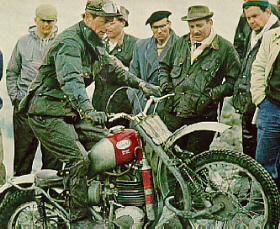The Greeves Story
by Patrick Frei (might be not accurate)
Greeves motorcycles began as a manufacturer of 3-wheeled cars for the disabled. Bert Greeves designed a vehicle for his cousin who had complained of the inadequacy of the typical battery powered units commonly available. Bert did the industry one better by producing a gas powered car that offered greater range and mobility. Invacar Limited was formed in 1946, and the small firm did surprisingly well.
The first Greeves trials bike, 1954. Greeves was a motorcycle enthusiast and believed there was a market opportunity for a line of good, lightweight motorcycles. In the early nineteen fifties, he began to design the machines and introduced his first two units to the motorcycling public in 1954. They were both dirt bikes, one being a trials machine, the other a scrambler model. These early units were powered by Villiers 200cc two strokes engines. From the start, these motorcycles were easily identified by two unique Greeves features: the leading link front fork and the cast aluminum "down beam".

1954

1956
Greeves believed competition improved the breed and could provide valuable exposure of the company's name to potential buyers. In 1957 he went racing with a highly regarded motocrosser at the time, Brian Stonebridge. Stonebridge enjoyed considerable success in Britain, and the small company's sales began to grow. In 1958, the pair traveled to the European continent to compete in the newly established FIM 250cc motocross class. In traveling Europe, Bert was shaken to discover that the British were "regarded as rather a second-rate race in sporting spheres". This revelation caused Greeves to redouble the company's racing efforts. The commitment paid off quickly, with Stonebridge garnering two second place finishes in the championship standings in the ensuing two years.
Following the tragic death of Stonebridge in an auto accident, the company hired Dave Bickers as their rider. With a new motorcycle punched out to 246cc, Bickers won the European championship in both 1960 and 1961.
1960 Hawkstone Scrambler It was about this time that
Greeves motorcycles began to show up in western states desert races. The little
silver and blue Hawkstones began to change peoples ideas about what kind of
hardware was needed to win. Before the Greeves, lightweight bikes were a joke.
They were unreliable and had difficulty even finishing. Greeves changed all that.
They not only finished, but were often beating the large bore desert sleds of
the day. For a ten year stretch, from 1959 to 1969, Greeves motorcycles became
the ones to beat.
The 1962 Mark II roadster with Villiers 250cc twin.
Greeves built road bikes as well as off road motorcycles. By 1962, there was 11
models, four of which were roadsters. In 1962,
Greeves introduced a new Villiers powerplant featuring a Greeves designed
cylinder head and barrel. The new cylinder featured revised porting for better
power and the familiar Greeves "square barrel" look. A year later, the company
produced the Silverstone road racer, an economical, 250cc bike for the privateer.
The reliability of the Villiers motor began to suffer as more and more horsepower was coaxed out of the square barrel design. It became clear to Greeves that an entirely new engine was needed to remain competitive in both speed and reliability. That new design made its debut in the 1964 250cc Greeves Challenger. The motor featured the Greeves head and barrel, a lower end built by the Alpha Company and an Albion gearbox. By 1967, a 360cc version was available. These were highly successful motorcycles, enjoying popularity in both desert racing and motocross events. Greeves also experienced considerable success in trials competition. In 1964, Don Smith won the European Trials Championship aboard a Scottish Trials. In 1967 he won a second time, riding an Anglian.
The Scottish Trials models were produced from 1960 through 1965, with introduction of the Anglian in 1966.


Don Smith's Scottish Greeves 1962
.jpg)
Greeves Team at Scottish Trial

Don Smith, 1967(?), on an Anglian

1967 THS Anglian Trials with modern forks
The last heroic act was, when W.Wilkinson won 1969 the Scottish on a Greeves, as Don Smith already competed on the Montesa Cota 250 and Sammy Miller on the Bultaco
The last of the Challenger models was produced in 1968, replaced by the 250 and 380cc Griffon motocrossers in 1969. By this time the familiar leading link fork was no longer offered, having been replaced by conventional telescopic forks. The leading link design could not be stretched to allow the now 7" travel of the telescopics. At various times the bikes were fitted with Ceriani, Metal Profile or Telesco's. Gone too was the familiar aluminum front down beam, more a victim of marketing strategy than engineering necessity. A new frame of Reynolds 531 chrome moly with a conventional down tube was now standard.